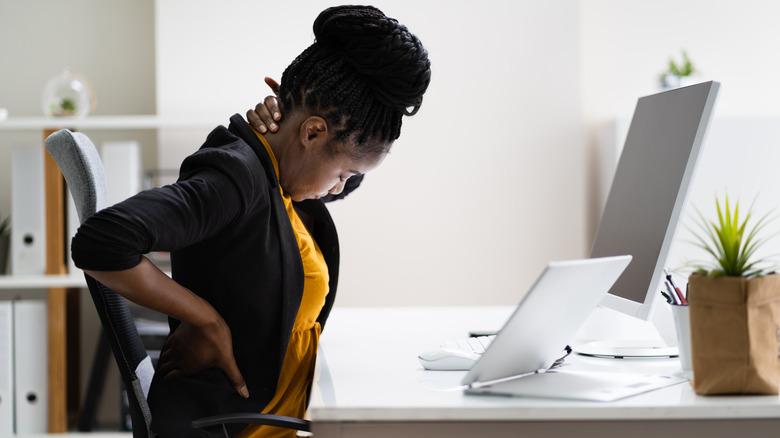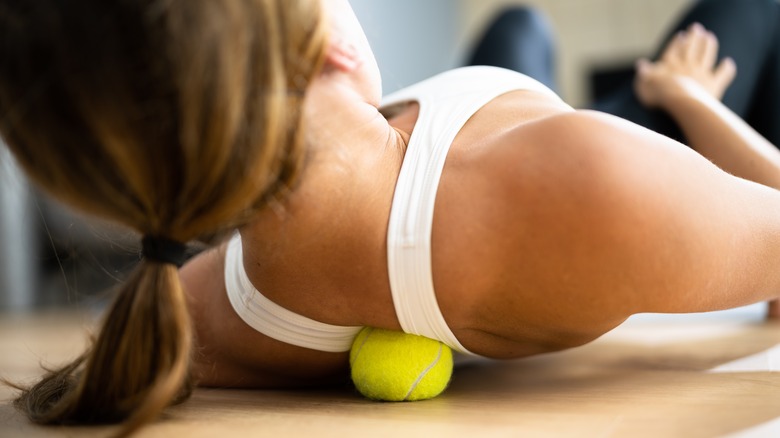The Simple Move To Stretch Out Neck And Shoulder Tension
POV: You're sitting at your desk – or maybe standing behind a counter — diligently working, when all of a sudden a sharp pain in your shoulder blade pulls you out of the moment. Wincing, you press your fingers into it to try to release some of the pressure, but it only offers a fleeting moment of relief. And just like that, your whole day becomes about trying to make yourself comfortable. What a pain!
If left unaddressed, neck and shoulder pain can be a real week-ruiner. And while a nice, hour-long massage can be restorative, not all of us have a magic-fingered masseuse on speed dial. Fortunately, there's a handy trick that can help you ease that tension yourself, and all you need is a tennis ball and your body weight.
Acupressure — a practice used in Traditional Chinese Medicine that treats blocked energy by applying manual pressure to specific points on the body — is much like acupuncture, but without intimidating needles (per Verywellhealth). A 2006 study published in BMJ found that acupressure was more effective in treating back pain than physical therapy. Tony D'Angelo, a physical therapist and VP of clinical operations at Professional Physical Therapy, told Men's Health that tension has a tendency to build around acupressure points, but with a little pinpoint self-massage, improved circulation, muscle healing, and pain-relieving endorphins can be yours! That's where your handy-dandy tennis ball comes in.
How to self-massage using a tennis ball
When your neck and shoulders are giving you trouble, East River Pilates instructor Brian Spencer recommends lying down on a mat and placing a tennis ball under your upper trapezius muscle — the one that starts at the base of your neck and stretches across your shoulders (per Well + Good). Once the ball is in place, begin making small, intentional movements with your head and neck. When you're ready, Spencer suggests adding in some arm movements, lifting your arm above your head or crossing your arms over your chest. The pressure on the trapezius muscle, coupled with the changes in position, releases pressure that causes shoulder and neck pain. When one side is good and loose, move the ball over to the other side and repeat.
You don't need to sprawl out across the floor to get your self-massage on. Charlee Atkins, a personal trainer and founder of Le Sweat, says you can try this move from the comfort of your desk chair (per NBC News). Simply put the ball between your upper back and the chair, lean back and move from side to side. If you want to go even deeper, Atkins recommends finding the nearest wall, placing the ball between your shoulder blade and your spine and leaning back against the wall to create pressure. With your head in a neutral position, lift your arm above your head and then put it back down by your side.
Where neck and shoulder pain come from and how to prevent it
If you find that you're constantly pulling out that tennis ball, you may need to take a look at your daily routine. According to Penn Medicine, there are a few seemingly harmless things you might be doing that may be contributing to your discomfort. While a good night's sleep is usually the best medicine, every so often you wake up with a crick in your neck that leaves you feeling like Uncle Fester from "The Addams Family." Dr. Harvey E. Smith, an orthopaedic spine surgeon at Penn Medicine, suggests this could be from sleeping with your neck at an unusual angle, and recommends sleeping on your stomach or back with the support of a well-formed pillow. Another common culprit is a heavy over-the-shoulder bag. Smith notes that we compensate for the asymmetrical weight by straining the neck and shoulder muscles in an attempt to keep the head upright. He recommends switching to a backpack for more even weight distribution.
Tech neck – a term used to describe the neck and shoulder pain, soreness and stiffness that come from looking down at a smartphone or computer for too long — plagues modern society (per NewYork-Presbyterian Hospital). A 2019 study published in PLoS One found a compelling association between the amount of time people spend on their phones and the severity of their neck pain. To prevent this, Everyday Health recommends stretching, checking your posture throughout the day, and taking hourly breaks.



